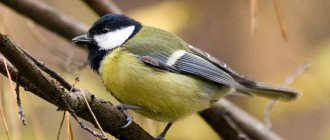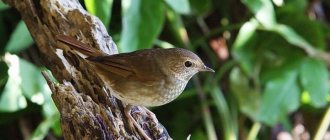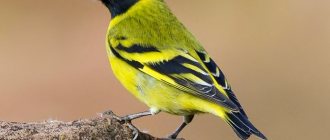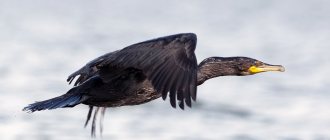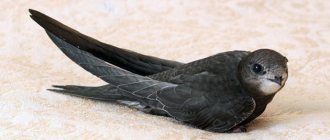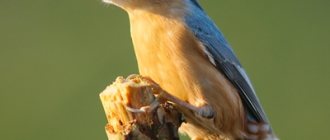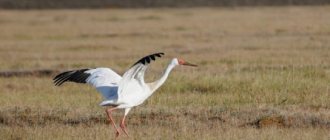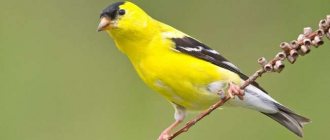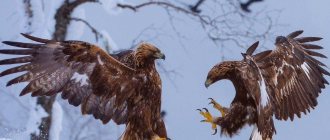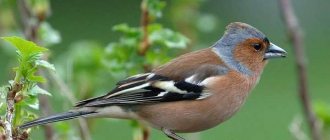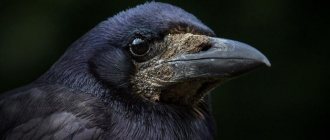Description of Tap Dance
Most often, the tap dancer is shown in the photo with a red chest or forehead. If you see such an individual, then this is a male. Females have a white breast, dark stripes on the wings, and only the “cap” is red. Both sexes have a beige abdomen and brown wings.
These birds have a fairly massive beak - up to 10 mm, dark yellow in color with a dark tip. The back of the bird is brown, in contrast to the linnet, whose back is brown. The bird's throat is black, which is the second difference between the heroine of the article. The same color mark is present on the bird's head. Our hero is no larger in size than a sparrow, body length does not exceed 14 cm. The wingspan is more than 20 centimeters, with a weight of 15 grams
A description of tap dancing would not be complete without paying attention to its character. The Tap Dance bird is very curious and mischievous
For its size, it is a fearless bird that often approaches people, flying into private yards to feast on the contents of feeders.
CHARACTERISTIC FEATURES OF THE OSCOPY. DESCRIPTION
Eggs: white with black or brown spots, the female osprey lays 2-3, less often - 4 eggs.
Nest: located high in the crowns of huge trees or on rocks.
Chicks: fed by the female. They begin to fly at the age of 50-60 days.
Distinctive features: brown plumage. The head is white, with a dark stripe running down from the eye to the middle of the neck. The wings are unusually long. Legs are strong, not fully feathered.
— All year — Wintering — Nesting
WHERE DOES IT LIVE?
Osprey is found on almost the entire sea coast and near fresh water bodies. The map shows the places where it winters and nests, as well as those places where it lives throughout the year.
PROTECTION AND PRESERVATION
In many places the osprey has become a rare species. The use of pesticides in agriculture and hunting has led to a decline in the number of this bird.
Drawing an osprey - the symbol bird of 2021
01/29/2018 News, Reserve news
A new Interregional art competition “Bird of the Year” is announced
For several years in our country, every year passes under the sign of a bird chosen by the Russian Bird Conservation Union
This good tradition, the purpose of which is to attract people’s attention to our feathered neighbors, to learn more about their life, numbers, problems associated with their protection, dates back to 1996. The selected species becomes a symbol of environmental work, special research is carried out on it, information leaflets and posters are distributed, children's drawing competitions and other events are held
Photo: Victor Tyakht
The humble brown-headed chickadee, the symbol of 2017, has been replaced in 2021 by the regal osprey. Osprey is an amazing winged predator. She is an excellent fisherman, so she prefers to live near clean waters rich in fish. Experts emphasize that the osprey feeds almost exclusively on fish; other prey is extremely rare in the osprey’s diet. This bird is a masterly swift flyer and is distinguished by its special grace - its bright contrasting color, which combines black, white, dark brown and fawn-gray shades. Osprey is widely distributed throughout the world, found on all continents except Antarctica. She makes long migrations. Research shows that ospreys from central Russia go to the countries of the African continent for the winter. The osprey is rare throughout its range. Water pollution and deforestation have led to a significant reduction in the number of feathered fishermen. Excessive human disturbance is also a determining limiting factor for ospreys.
The interregional art competition “Bird of the Year” is held by the Federal State Budgetary Institution “Prioksko-Terrasny State Natural Biosphere Reserve” from February 2 to April 2. The competition was organized with the aim of cultivating interest and familiarizing adults and children with the characteristics of this amazing bird, its protection and study.
Objectives of the Competition: - to popularize among the general population of the Moscow region and other regions of Russia a careful attitude towards the environment and the topic of preserving biodiversity and ecological balance - to teach people to understand, appreciate and carry out tasks for the conservation of rare bird species in our region.
Applications for the Competition are submitted in the thematic area “Best bird drawing of 2021”, within which the winners (1st place) and runners-up (2nd and 3rd places) are determined.
We remind you that all your creative work must be biologically accurate and based on your careful study of osprey images and popular publications about its lifestyle.
We look forward to your artwork and wish you creative inspiration!
Photo: Oleg Sidorov.
Population and species status
Photo: What an osprey looks like
The osprey is classified as a species of increasing abundance in the latest IUCN Red List. The size of the global population is estimated at 100 - 500 thousand individuals. Indeed, conservation measures (ban on the use of long-lasting pesticides and the shooting of birds of prey) have led to a noticeable increase in the number of birds on all continents. In Europe, where the situation was most dire, the remaining populations in Scandinavia and Germany increased. Birds returned to England, Scotland, Bavaria, and France. According to foreign data for 2011 - 2014. in Great Britain there were 250 - 300 residential nests, in Sweden 4100, in Norway - 500, in Finland - 1300, in Germany - 627, in Russia - 2000 - 4000.
In the Red Book of Russia, the species has status 3 (rare). According to the data given in it, the largest number of nests (about 60) are in the Darwin Nature Reserve (Vologda region). There are several dozen pairs in the Leningrad and Tver regions, on the Kola Peninsula and in the lower reaches of the Volga. Less than ten pairs live in the Nizhny Novgorod region and the rest of the Non-Black Earth Region. In Siberia, small nesting sites have been noted in the north of the Tyumen region and the south of the Krasnoyarsk Territory; most of these predators (about 500 pairs) live in the Magadan and Amur regions, Khabarovsk Territory, Primorye, Sakhalin, Kamchatka and Chukotka. In general, no more than 1000 couples throughout the country.
We are beginning preparations for the SOPR campaign “Osprey – Bird of the Year 2018”
The City Center for Children's Environmental Education (GCEDE) informs that the Russian Bird Conservation Union (SOPR) has chosen the osprey as the 2018 Bird of the Year.
November 29 at 14-00
A GMO on ecology “Greenization of the pedagogical process within the framework of the project “Children and Birds” as a condition for the formation of environmental consciousness” will be held at the Center for Education and Science, at which issues related to the requirements for your methodological and didactic materials will be considered.
Reception of methodological and didactic materials – until December 25, 2017.
Your material will be selected by teachers of the State Center for Detection of Economics for publication on the website of the State Center for Detection of Economics.
Selection criteria:
- pedagogical feasibility;
- originality of the material;
- factual reliability of the material;
- consistency of structure, style and clarity;
- possibility of wide use.
Note: you prepare detailed notes and detailed teaching materials for your educational institution, but in the State Center for Detection and Education you present an abbreviated version of the material, which is pre-selected by the administration of the educational institution, and not by the teachers of the State Center for Detection of Economics.
Requirements for materials and their presentation:
- application with the seal of the educational institution (full name of the authors, the responsible administrator, i.e. someone from the administration of the educational institution must look at your material and recommend it). The application file must be named: last name of one of the authors_figures OU_application ( Ivanova_school_99_application
); there must be a blue stamp on the application, then you scan it; - ONE material is accepted from each educational institution, with no more than 3 authors (the authors should not be published by the State Center for Detection of Economics on the topic “Bird of the Year” for 2021 and 2021)
- The full name of the author (authors), position and name of the educational institution shall be indicated;
- format of one material - no more than one page A4 font Times New Roman, font size 12, line spacing - single). Each page has all margins (bottom, top, left, right) - 15 mm. You can only use the following text highlighter: bold;
- A list of information sources is required. Example:
1. Brem A. Birds: In 2 vols. Vol. 2. – M.: AST Publishing House LLC, 1999. – 529 p., ill. 2. Bugaev A.G. Birds. School guide. – St. Petersburg: LLC “BKK”, 2008. – 96 p., ill.. 3. Red Book of the Ryazan Region: official scientific publication. Rep. ed. V.P. Ivanchev, M.V. Kazakova. Ed. 2nd. Ryazan: NP “Voice of the Province”, 2011.V.E. Flint. Birds of European Russia. 2000. P.182. 4. https://www.naturekeepers.ru
Submitted materials must be provided free of charge
tested in the Antiplagiat system on the Internet service www.antiplagiat.ru. You must also provide the results of the check in this system as an attachment to your letter. If the uniqueness of the text is less than 75%, then the material will not be accepted for consideration.
Materials submitted to the Competition must be educational in nature and not contradict generally accepted scientific facts, ethical standards and legislation of the Russian Federation.
Attention! Submitted works are not reviewed. The organizing committee of the competition reserves the right to check the submitted materials with the Anti-Plagiarism system. The file of your work should be named: Last name of one of the authors_OU_figure (Ivanova_DOU_183), and not "Bird_2018"
The plagiarism check file should also be named: Last name of one of the authors_figures OU_antiplagiarism, and not just “Antiplagiarism”
The file of your work should be named: Last name of one of the authors_figure OU ( Ivanova_DOU_183
), and not “Bird_2018”. The file for checking for plagiarism should also be named: Last name of one of the authors_figures OU_antiplagiarism, and not just “Antiplagiarism”.
Text materials are accepted by email: [email protected] mail.ryazan.ru or electronically at the address: st. Oktyabrskaya, house 37; 2nd floor, office No. 22 (“CDT “Prioksky”).
January 25, 2021
The city seminar “Osprey – Bird of 2018” will take place at the Prioksky Central Children's Centre. The best methodological and didactic materials on this topic will be presented at the seminar, which will subsequently be posted on the State Center for Economic and Social Extension website.
Osprey attacks. Video (00:00:58)
Looking into an osprey's nest is a very difficult task: the nests are high and at the very top of the tree. There was nothing to hold onto there, the branches were falling off the nest, and in one hand I still had a huge shoulder-mounted camera... And once, at the height of a five-story building, I lifted the camera into the nest on a heavy tripod at random, holding it by the tip with one hand. It would be worth slightly deflecting this thing from the vertical and all the equipment would fly down and break into pieces. Miraculously he held on. And this nest is one of the few that you can look into. I actually climbed one nesting tree - and turned back halfway - it was so dry that the entire upper part could fall off...
Osprey
Osprey is an ichthyophagous bird. It feeds almost exclusively on fish, which it tracks by flying low above the water. At times, the osprey “hangs” over the pond, looking for prey. When it sees a fish, it dives with its paws extended forward, sometimes completely disappearing into the water. The bird's feathers have a water-repellent structure, and special valves close the nostrils when diving.
Where does he live?
Osprey is found everywhere except Antarctica and some oceanic islands. Most often, the osprey inhabits the banks of rivers, lakes, and less often sea coasts.
In our country, its nesting range lies within the forest zone, in some places covering the forested floodplains of steppe rivers.
Osprey settles near large bodies of water rich in fish, where it hunts most successfully in shallow water with clear, calm water.
Ospreys fly away for the winter in September-October. Birds of the European part of Russia winter in East Africa, Siberian populations - in South Asia.
What does it look like
The osprey is characterized by contrasting black and white plumage
This swift, bird of prey reaches 58 cm in length. The wingspan is 145–170 cm. The gray top of the plumage contrasts with the white underside, head and neck.
On each side of the bird's body, starting from the beak, through the eye area and back to the base of the wings, there is a grayish-brown stripe: it seems as if the osprey is wearing a kind of mask. She has a speckled “necklace” on her neck, which is much more noticeable in females.
The predatory gaze of an osprey, even a young one, pierces through and through. Female ospreys are larger than males and are about 20% heavier. The maximum weight of a male is 1.6 kg, and that of a female is 2 kg.
Great fisherman
Osprey with prey
Osprey is an excellent fisherman. However, its plumage is not adapted to getting wet. Osprey hovers at a height of about 20 m above the water, looking for prey on the surface of water bodies. Then it falls down like a stone and grabs the fish without diving.
The bird has four toes on its feet, which are of the same length, but one of them is reversible: it can be placed forward and backward. If the catch is large, the osprey grabs it like claws - two fingers in front, two in back.
On the inside of the fingers there are additional devices for holding prey - pads with sharp spines, which make the already powerful grip even more reliable. Once caught in the clutches of a predator, the prey has virtually no chance of escaping.
Population
Osprey is a rare bird listed in the Red Book of the Russian Federation. The bird is surprising, first of all, because it is the only representative of its family - such are rare in the animal world! The number of species throughout Russia is unknown.
In the European part, apparently, no more than 300-400 pairs nest.
The number of this beautiful predator is declining due to direct extermination: shooting and destruction of nests, as well as due to pollution of water bodies, leading to a decrease in the number of fish, due to the cutting down of old dead trees - potential nesting sites, and also due to disturbance from sides of a person.
Osprey in flight
Only in 1964 was a ban on the shooting of birds of prey introduced in Russia. However, the number of the species was never able to recover, apparently due to the widespread use of organochlorine pesticides in those years, which, together with fish, entered the body of birds in large quantities. Only in recent years has there been a slight tendency towards population recovery of this species.
Population
At the moment, the number of ospreys is alarming. Birds are listed in the Red Book of a number of countries, as well as in various environmental documents. In some regions, the small number of these birds is associated with hunting by poachers, poisoning of their habitat with pesticides, and a reduction in the amount of food supply. In Europe and North America, it was possible to restore the number of ospreys through the introduction of environmental measures and the creation of conditions for artificial nesting.
Eunuch's diet
Skopets is a bird whose menu mostly consists of “fish dishes”. According to scientists, fish makes up more than 90% of everything eaten by the predator. That is why in the world of feathered creatures this species is considered one of the best hunter-divers. In addition, fresh fish serves as an excellent source of moisture for the predator, and therefore it rarely drinks plain water.
However, this does not mean that the eunuch does not hunt other game. If the weather or terrain does not allow fishing, the bird easily switches to other targets. For example, rodents, reptiles, insects and even other birds can become dinner for a predator. Moreover, there is evidence that eunuchs hunted animals that could become formidable opponents in their own right.
Where does the osprey live?
Photo: Osprey in flight
The range of the osprey with all its subspecies covers the temperate, subtropical and tropical climate zones of Eurasia, Africa, the Americas, as well as Australia and Oceania. The birds are distributed unevenly throughout their range; they are found quite rarely and scattered. Desert and high mountain areas are avoided.
It is possible to identify areas of the range where:
- migratory birds nest;
- resident ospreys live;
- migratory birds are encountered during seasonal migrations;
- migrants from the north spend the winter.
On Russian territory, the northern border of the range approximately coincides with 67° N latitude. in the European part, then passes along latitude 66° in the Ob basin, to the east it moves even further south: to the mouth of the river. Lower Tunguska, lower reaches of Vilyuy, lower reaches of Aldan. Along the Okhotsk coast it runs north of Magadan to Kamchatka. The southern border in the European part runs in the lower reaches of the Don and the Volga delta. In Siberia and the Far East, the osprey can be found right up to the southern border of the country.
In Russia, the predator often chooses the banks of reservoirs as a place of residence, surrounded by old trees (pines) with withered tops. Loves swampy sparse forests and vast lakes with clean, shallow water, rivers with riffles and reaches. Does not shy away from sea coasts and islands. Nesting sites are mainly limited to the forest zone, although birds can also settle outside it - in the floodplain forests of the steppes. On migration they can be found in open steppe areas. In southern treeless areas, sedentary ospreys build nests on the cliffs of sea coasts, on coastal islands and even in small coastal towns.
Now you know where the osprey fisherman lives. Let's see what he eats.
Order "Birds of Prey": American Vultures
Diurnal birds of prey of the American vulture class also have few species - only 7, most of which, unfortunately, have become extinct.
California condor
A very rare species of large birds that can fly. Their weight range is from 7 to 14 kg, length up to 110-140 cm, and wingspan 240-305 cm. The diet is based almost exclusively on carrion. It has black plumage with white feathers on the inside, a head and neck without feathers, with folds. Around the neck is a collar of sharp, protruding feathers.
Condor
Andean condor
This is the only representative of the monopolistic condor genus. One of the largest birds, in which the male is heavier than the female - up to 15 kg and 11 kg, respectively. The wingspan reaches 270-310 cm. It has a black color with former stripes on the wings and a white collar, which is larger in males, and a head without feathers.
Memorable appearance
Royal vulture
The brightest of the representatives of this family. They also have a bald head and neck, but with bright growths and colors, the plumage is white with black edging on the wings and tail. The length can reach up to 85 cm, weight up to 4.5 kg, and wingspan up to 2 m. They feed on carrion, but also on fish, snakes, and mammals.
Bright
Urubu vulture or American black catarrh
The plumage is black, only light in the lower part, the head and neck are bald and wrinkled, dark gray in color. It lives in North and South America in the tropical zone. It feeds on carrion.
Description
Greater yellow-headed catarrh
Representative of South America. The plumage is black with green or purple highlights. The name was given for the bright yellow or orange coloring of the head.
DimensionsLesser large-headed catarth
Representative of Central and South America. They feed on carrion.
Dimensions
Turkey Vulture
Bird of prey of North and South America. It has a very small red head, black-brown plumage, and wings with a gray-silver tint.
Vulture
The Birds of Prey order are special birds that inspire both fear and admiration at the same time. They look graceful and majestic, but they can be dangerous.
Top 3: the most interesting facts about the osprey
- Nature has endowed the osprey with deadly claws with which it grabs its prey. In this case, the fish is always carried through the air in one position: held by its paws near the head and tail. This ensures optimal aerodynamics.
- Despite their menacing appearance, ospreys are quite peaceful, and sometimes downright defenseless. Even impudent crows can take fish away from this bird. There are cases when an osprey had to feed all its feathered neighbors and carry its prey to the nest.
- It is noteworthy that the peacefulness of these birds extends exclusively to those who want to take away their prey. If danger threatens the nest, the osprey transforms, turning into an angry fury, ready to fight to the death.
Breeding offspring
At intervals of 1-2 days, the female lays from 2 to 4 white eggs with brownish-red specks. Both parents incubate the clutch for about 40 days, but even when the female remains in the nest, the caring husband brings part of his prey to the nest. And if he has two nests in his care, he manages to feed both females.
The chicks are born in the same order that the eggs were laid. Newborns are covered with light white fluff and for the first 10 days of life the female warms them and protects them from bad weather, while the male brings food. To feed the female and offspring, he needs to catch at least 3-10 fish weighing about 100 g each. The prey is carefully cut into pieces and fed to the chicks. If there is a hungry year and there is not enough food, the chicks that hatch first survive.
Osprey eggs in a nest.
A pair of ospreys on a nest with chicks.
The osprey brought prey to the chicks.
Photo of an osprey nest with adult chicks.
An osprey flew to the nest.
A juvenile osprey on a man-made nest.
At the age of 2 weeks, the chicks begin to develop feathers, and at 2.5 months, young ospreys are fully feathered. The chicks grow very quickly; after another month, the offspring are only 20% smaller than their parents. Now the younger generation begins to hunt on their own, but often children return to the nest to be fed by their parents.
WHAT DOES IT EAT?
Osprey feed almost exclusively on live fish. Only when the water in the reservoir is very muddy is it forced to also catch frogs and small rodents, and sometimes even chases ducks and jackdaws. When hunting, the osprey first soars in the air at a high altitude, then descends to a height of 20-30 m and begins to rush over the water. At times she stops and hovers in the air, fluttering her wings, to more closely monitor the spotted fish. Then, stretching its legs forward, the osprey quickly descends onto the water at an angle to the surface and disappears under the waves.
However, the bird soon appears on the surface and takes off with the prey, taking it to a secluded place. Most often, osprey catch fish weighing 200-400 grams.
Reproduction
Ospreys are monogamous, but migrating females and males arrive at the nesting site separately - the male usually arrives several days earlier. Both partners collect material for the nest, but it is mainly the female who builds it. The nest is built from twigs and then entwined with algae or grass. Various objects floating or lying on the bottom can also be used as building material, for example, fishing line or plastic bags, etc. The osprey uses the same nest for several years in a row, but every year it is completed and put in order.
Once the nest is built, the male begins to obtain food for the female, and this process continues until the hatchlings fledge. The female lays 2-4 eggs at intervals of one to two days each. Both parents participate in incubation, which lasts about 40 days. The chicks hatch in the same order that the eggs are laid - one every day or two. The first chicks grow earlier and become stronger. If there is not enough food, the weaker later chicks often die. Small chicks are not able to maintain normal body temperature, and the female warms them almost all the time for the first two weeks. She then continues to care for them if the weather is too cold or hot until they are about 4 weeks old.
The hatched chicks are covered with white down, which gives way to dark gray after about 10 days. The first feathers begin to appear after about two weeks, and the chicks are fully feathered after 48-76 days. After a month, the chicks reach 70-80% of the size of their parents. They stay in the nest for an average of 55 days. Having left it, the chicks begin to hunt on their own, but for some time (from 2 to 8 weeks) they return to the nest from time to time and receive food from their parents. Because ospreys migrate individually, the young should become completely independent of their parents by the time they migrate in the fall. Both parents feed the chicks and protect them from predators and bad weather. The male brings 3-10 fish (weighing 60-100 g) to the nest every day. In the nest, the male or female divides the fish into pieces and feeds it to the chicks. Young ospreys usually reach sexual maturity at the age of three.
Features of character and lifestyle
Photo: Osprey fisherman
In southern regions with warm winters and ice-free reservoirs, ospreys live sedentary lives, and where winter fishing is not possible, they become migratory birds. They fly from North America to South America, from Europe to Africa, from the north of Asia to the south and southeast of Asia. They leave for the south from September to October, returning in April – May.
Sedentary birds, free from family worries, can also wander, making flights for food lasting several hours. Usually they do not fly further than 10-14 km from their place of residence. The "language" of the osprey is quite poor. Basically, these are a series of gentle, sonorous screams, varying in tone and duration.
Interesting fact: These predators prefer fish weighing 150-300 g, the record weight of prey is 1200 g. The length of the fish is 7 - 57 cm. In order to eat, a bird needs 300 - 400 g of food per day, according to other sources, up to 800 g is needed .
The mortality rate of young birds under 2 years of age is high - an average of 40%. The main reason for the death of young animals is lack of food. But ospreys can live for a long time - 20 - 25 years. In 2011, a record of longevity was recorded - 30 years, in 2014 - 32 years... Perhaps this is not the limit.
Breeding in captivity
The process of breeding these birds in captivity is similar to their behavior in the natural environment. For birds that have created a pair, it is necessary to bring the diet as close as possible to what the birds would receive in their natural habitat. You should increase the amount of protein foods and introduce into your diet:
- insects,
- insect larvae,
- ant eggs.
Future parents should also be isolated from outside interference and anxiety from others
When kept in captivity, birds, although they are not completely tamed, are in good contact with each other, and in groups they fill the house with the enchanting sounds of natural singing.
Osprey diet
It consists of more than 99% of a variety of fish, since the osprey is not picky and grabs everything that moves closer to the surface of the water. True, when the fish assortment is extensive, the osprey chooses 2–3 of the most delicious (in its opinion) species.
Ospreys often hunt in flight (occasionally from ambush): they hover over the surface of the water, rising no higher than 10–40 m. With this method of hunting, water transparency is important for ospreys, since it is very difficult to see prey in a muddy body of water.
Hunting
An osprey effectively rushes after a fish from a height - having noticed it from a low-level flight, the bird half-folds its wings and stretches its paws forward, rapidly falling onto the prey in a vertical peak or at an angle of 45 degrees. Often it goes under the water entirely, but immediately flies up, carrying the trophy (usually pointing head first) in the claws of one or both paws.
Long claws, whose bottom fingers are studded with sharp tubercles, as well as a backward-facing front finger (for securely capturing prey) help to hold a slippery fish.
To take off from the water surface, the osprey uses a powerful, almost horizontal wing stroke. In the air, it habitually shakes itself off and flies to a tree or cliff to leisurely have lunch. Having completed the meal, he returns to the river to wash off the fish scales and mucus, dipping his feet and head into the water.
Production
An adult osprey weighing 2 kg is not afraid to fish for prey equal to or even greater in weight, pulling out three- and even four-kilogram fish. True, this is more an exception than a rule - much more often she carries around one hundred or two hundred gram fish.
It happens that an osprey does not calculate its strength and digs its claws into an unbearable prey weighing 4 or more kg. If the bird does not have time to release its claws, the heavy fish drags it to the bottom.
Fishermen periodically catch large pike and carp with a creepy “decoration” on their back - the skeleton of a dead osprey. There is also a photograph of one such find, which shows a large carp (caught in Saxony) with a dead osprey sitting on its ridge.
Details
The bird eats the fish starting from the head. If the male is feeding the female at this time, he eats part of the catch, taking the other part to the nest. In general, ospreys are not accustomed to hiding what they have caught: they carry it, throw it away, or leave the remains in the nest.
It is known that ospreys disdain carrion and hardly drink water, satisfying their daily need for moisture with fresh fish.
Ornithologists also calculated the percentage of successful dives (24–74%), noting that the indicator is influenced by weather, tides and the abilities of the osprey itself. One percent of the bird of prey menu is occupied by frogs, water voles, muskrats, squirrels, salamanders, snakes, small birds and even tiny crocodiles.
Osprey
| Latin name: | Pandion haliaetus |
| English name: | Osprey |
| Squad: | Birds of prey (Falconiformes) |
| Family: | Ospreys (Pandionidae) |
| Body length, cm: | 55–58 |
| Wingspan, cm: | 145–170 |
| Body weight, kg: | 1,1–2 |
| Features: | silhouette in flight, plumage color, fishing technique |
| Number, thousand pairs: | around 5 |
| Security status: | SPEC 3, CEE 1, BERNA 2, BONN 2, CITES 1 |
| Habitats: | Wetland species |
| Additionally: | Russian description of the species |
This species can be recognized by the dark brown upper part of the body, contrasting with the white lower part. If you look at the bird from below, you can clearly see blackish dots and dark spots on the wings (at the tips and folds); the tail is marked with frequent transverse stripes. The paws are covered with special scales and are equipped with downward-curved claws that allow the osprey to hold slippery prey. There is no sexual dimorphism. Distribution. A migratory and nomadic species with a worldwide but intermittent distribution. Absent in South America and most of Africa, in Europe it is more common in the northern and eastern regions. Spends the winter in Africa and the Mediterranean basin. In Italy, in the second half of the 1960s, the osprey stopped nesting in Sardinia and Sicily, but it is common here during the migration period; a limited number of individuals spend the winter. (Widely distributed in Russia, but extremely rare everywhere.)
Habitat. Settles near lakes, rivers, and less often seas rich in fish.
Biology. Builds a fairly large nest in trees, on the ground or on rocky ledges. In April, it usually lays 2–3 eggs, from which chicks hatch on the 37th day of incubation, carried out mainly by the female. The young begin to fly at 7–8 weeks of age. One clutch per year. In flight, an osprey is recognizable by the outline of its wings, which it holds at a slightly angled angle. When near the nest, it emits repeated whistles.
Security. The osprey is threatened by changes in the environment, extermination during migration, water pollution and human disturbance. However, where this species is protected, there is a tendency for its numbers to increase and for it to colonize new territories.
Osprey (Pandion haliaetus)
Origin of the species and description
Photo: Osprey
The species was described by Linnaeus in 1758. The generic name Pandion is given in honor of the mythological Athenian king Pandion I, who was transformed into this bird by the divine will of Zeus. Although there is a version that Pandion II was meant and his son turned into a bird. The specific epithet "haliaetus" is composed of the Greek words meaning "sea" and "eagle". The origin of the Russian name is not clear.
Video: Osprey
The most ancient fossil remains of representatives of the family. Skopins are found in Egypt and Germany and date back to the early Oligocene (about 30 million years ago). Fossils that can definitely be attributed to the genus Osprey have been found in later Miocene-Pleistocene deposits in southern North America. The closest relatives of the osprey are united in the order Accipitidae.
Populations of modern osprey in different geographical regions have distinct features, which allows us to distinguish 4 subspecies:
- the type subspecies living in Eurasia, the largest, with a dark color. Migrates;
- The Carolina subspecies is common in North America. In general, it looks like a typical one. Migrates;
- Ridgway's subspecies is found in the Caribbean. It is distinguished by a light head (in the sense of coloring, not intelligence). Lives sedentary;
- the crested subspecies inhabits Australia and Oceania, the Indonesian archipelago. The individuals are small, with characteristic feathers raised on the back of the head - crests.
The last subspecies is often distinguished by morphologists as an independent species: the combed or eastern osprey (Pandion cristatus). Although researchers who prefer molecular genetic methods of classification believe that all subspecies equally deserve species status.
Habitat and lifestyle
This bird species is common on almost all continents. They definitely don't live in Antarctica. In winter, ospreys fly to warm countries, for example, to Egypt. There they settle on the islands of the Red Sea and nest. In summer, the bird can be seen throughout almost all of Europe. The predator reaches the shores of Iceland and Scandinavia. Predators like to settle near various bodies of water, especially in places with shallow water. There are usually large numbers of fish there, which makes for excellent hunting for the osprey.
Osprey
Only ospreys living in the northern regions of the planet fly away for the winter. Those living in the southern parts of the planet lead a sedentary lifestyle and do not fly away from their homes. In places with excellent living conditions, they settle in groups, for example, along the coastline in warm places. Predators can jointly hunt prey and build nests together.
In case of attack
Nutrition
The osprey is often called the angler's eagle or sea eagle. This is due to the fact that the predator’s daily diet consists of 80% fish. They mainly catch small fish floating on the surface of the water, since they cannot dive deep. Hunting always takes place over a body of water. The bird flies above the water at an altitude of 10–40 meters. When the bird discovers future prey, it will suddenly rush into the water. When flying down, the osprey's wings rise and retract upward, and its paws descend downward into the water. As soon as the predator grabs the prey, its wings flap upward sharply and almost horizontally in order to quickly break away from the surface of the water.
The osprey holds its prey with both paws so that it does not interfere with it during the flight. The predator begins to eat the caught prey from the head; it practically does not eat the rest. The bird can take the remaining meat to its nest or throw it away. Several factors can affect a successful hunt:
- ebbs and flows;
- weather.
Predators also feed on other foods. These can be small water and land animals:
- rats;
- snakes;
- field mice;
- muskrats;
- small birds;
- proteins.
Ospreys practically do not drink water, since there is a sufficient amount of water in the fish, which is enough for them.
Reproduction
The breeding season for ospreys depends on the species of bird; for migrating and sedentary birds it occurs at different times. For those who live in one place, the mating season begins in December-March. For migratory birds from the northern regions, the mating season lasts from April to May.
When the female appears, the males begin circling the nest, attracting her and scaring away other males. After choosing a partner, the pair begins building a nest together. Often the female independently finds material for arranging a nest. Typically, birds are collected for construction:
- dry branches;
- grass;
- some items from water (old fishing line, bags).
An osprey's nest is a place to live for a long time, so every year the birds repair it and take care of it. Females lay eggs not simultaneously, but with pauses. She lays one egg at intervals of 1–2 days. The first chicks are always stronger and healthier than the others that appear later. They often do not have enough food for normal development. A total of 2–4 chicks appear. For 40 days, both parents incubate the eggs. The parents feed the emerging chicks with fish caught by the male.
A caring female divides the fish between the chicks, tearing it into pieces. To warm her offspring, she covers them with her body. After 1–1.5 months, the cubs begin to learn to get food on their own by hunting for prey. With the onset of autumn migration, the cubs become ready for independent life.
Osprey behavior and nutrition
These are solitary birds, they form pairs only during the mating season, and the rest of the time the birds live and hunt alone. The main source of food for ospreys is fish. The predator flies above the surface of the water, at an altitude of about 30 meters, and looks for prey. Having discovered the prey near the transparent surface of the water, the osprey descends and grabs it with its paws. The paws have sharp claws and additional spines that help hold slippery fish. To take off, the osprey flaps its wings vigorously and rises into the air.
Ospreys are loners.
Osprey mainly hunts fish whose body length is 25-35 centimeters and weighs 150-300 grams. But these predators can lift prey weighing up to 2 kilograms into the air.
Detachment “Day Birds of Prey”: photo and brief description of the Sokolin class
Diurnal birds of prey in the Falcon order contain 11 families and 60 species.
Lesser kestrel (steppe)
This is a small predator of the Falcon species. The female differs from the male in size and color of plumage, so it is impossible to confuse them. The only similarities they have are their dark eyes framed in yellow and a strong beak. The male has a blue-gray head, a reddish-brown back, a light-colored underpart without a pattern, and the tail feathers are blue-gray edged with black. The female has a rusty brown back and rufous tail feathers that are covered with black stripes and edged with a white outline.
Listed in the Red Book of Russia!
Comparison
Merlin
It belongs to the genus of falcons in North America and the northern latitudes of Eurasia, for example in Norway, Sweden, Finland, Iceland and Siberia. This is a fairly large bird, about 55-60 cm. Females and males look the same, but the female is larger and heavier by about 0.5-1 kg. Depending on the area of residence, their upper plumage varies from brownish-gray or with a blue tint to light gray; the abdominal region is always light. They have dark spots all over the body, the so-called mustache near the mouth opening is barely noticeable. The beak has a tooth characteristic of falcons, and the paws are yellow.
The population is declining!
Merlin
Peregrine Falcon
Known for their speed, peregrine falcons are the fastest on the planet. Their vertical speed during diving is more than 300 km/h; during normal flight while hunting, they can reach 100 km/h. Females are larger than males. Body length ranges from 34-50 cm, male weight up to 750 g, females reach 1.5 kg. The wingspan is up to 1.2 m. Both sexes have slate-gray wings, back and hood with a black tint, and pale bellies marked with brown stripes.
The population is declining!
The fastest
Appearance
Osprey is a fairly large bird, with a body size ranging from 55 to 58 centimeters in length and a wingspan of around 150 centimeters. The head color is white with a characteristic black stripe that starts from the beak and ends at the back of the head. The upper part of the body is black and gray. On the chest is a necklace of black feathers. There is a small crest in the back of the head. The feathers themselves look a little ruffled.
Depending on the habitat, body color may change. However, all species have very long, bow-shaped wings with a characteristic curve near the wrist joint. Due to its wing structure, in flight the osprey becomes similar to a seagull. The osprey's tail is also noteworthy, as it has the ability to spread out like a fan. The eyes are yellow. The beak is slightly curled and dark.
Sexual dimorphism consists in the predominance of black in the female’s plumage, as well as a pronounced strong necklace in the neck area. Individuals can also be distinguished by weight: females are almost 20% heavier than males.
Monarch Butterfly Migration
The reason for migration of monarch butterflies is wintering. Every year, in the fall, more than 100 million individuals of this beautiful insect set off on a six-week flight to warm countries. They start their travels from the USA and move towards California, Mexico and the Bahamas. In order to reach a comfortable country for wintering, they are ready to travel more than 4000 kilometers.
The main reference points for butterflies are the Sun and the earth's magnetic field. Orientation occurs due to magnetoreception that occurs in their body.
For Monarchs, winter migration is part of the biological cycle. Since butterflies do not have a long life, the first generation may simply not complete the migration. It happens that during migration one generation can be replaced by another and complete the process that has begun. The question of how long a monarch butterfly lives is difficult to answer unambiguously; there are habitat and climatic conditions, and, of course, the presence of natural enemies. In general, under good circumstances, the monarch butterfly can live as an adult for about one year.
Natural enemies of osprey
Photo: Osprey bird
Even such a large predator has enemies. These are even larger predators - eagles, which displace the osprey, competing with it for food and places to build nests. And those that operate under the cover of darkness are owls and eagle owls, which prefer to carry off their chicks.
Among the terrestrial animals that destroy nests we can name:
- snake;
- raccoon;
- small climbing predators;
- crocodile He catches an osprey in the water as it dives.
Naturally, the man also became one of the enemies, although not on purpose. It turned out that ospreys are very sensitive to pesticides, especially DDT and its derivatives, which were previously held in high esteem. These chemicals entered their bodies through fish and caused thinning of the egg shells and the death of the embryos, and ultimately a decrease in the birth rate. Adult birds also died. Between the 50s and 70s of the last century, the number of breeding pairs on the Atlantic coast of the United States decreased by 90%; on the Chesapeake Bay there were half as many. In Europe, in a number of countries (in the Pyrenees, England, Ireland, France), ospreys have completely disappeared.
The number of ospreys is also negatively affected by intensive land development: deforestation, fishing, and pollution of water bodies. Hunters make their contribution, those who like to destroy nests and simply show morbid curiosity.
Interesting fact: Osprey populations in Ireland disappeared by the beginning of the 19th century, in England they disappeared in 1840, in Scotland in 1916. The reason for the destruction was mass interest in collecting eggs and stuffed animals. The stupid hobby passed, and migrating ospreys began to populate the islands again. In 1954 they again nested in Scotland.
Natural enemies
In North America, osprey chicks and, less commonly, adults are hunted by the great eagle owl and the bald eagle.
The following are also recognized as natural enemies of ospreys:
- eagles and owls;
- raccoons and martens (destroy nests);
- cats and snakes (destroy nests).
Birds wintering in hot countries are attacked by some species of crocodiles, in particular the Nile: it grabs an osprey diving for fish.
